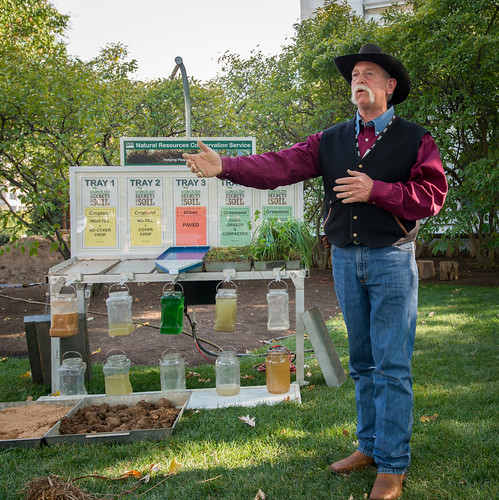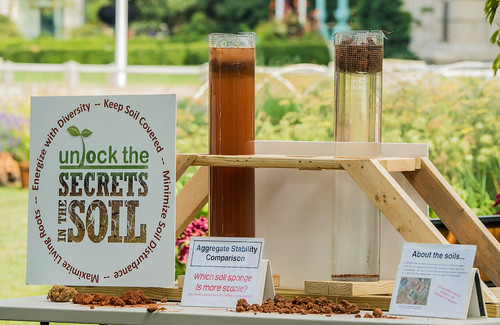
Recently, I watched Jason Weller, chief of USDA’s Natural Resources Conservation Service, (NRCS) provide testimony on the benefits of soil health during a House Agriculture Committee hearing. After the Chief’s impassioned testimony, I met with the crew setting up the rainfall simulator demonstration on the lawn of the USDA’s Whitten Building.
I couldn't help but hope that the “Bundled Benefits of Soil Health” event would effectively illustrate what Chief Weller had only hours earlier discussed with lawmakers. Before long, the audience began to assemble and people passing by from the National Mall stopped to watch as a cowboy from Oklahoma, Greg Scott, a retired NRCS soil scientist and Chris Lawrence, NRCS cropland agronomist in Virginia, delivered the event’s soil health message.
I had only seen this demonstration delivered to rural farmers and ranchers and wondered how this would translate to a more urban audience. I looked at the piles of soil on the demonstration tables and the silent rainfall simulator and wondered: “Will the audience get it?”
As Chris and Greg began talking about the soil, they spoke of soil as a living, breathing organism and that we, as casual observers, may not be able to discern the micro-ecosystem before us. To demonstrate, they used two soil samples that were visually similar in color, texture and type and invited the Chief up to the table to closely observe these two seemingly similar soil samples.
Chris told the crowd that one was healthy, had more organic matter, more living organisms and more pore space. The other had been tilled and left bare season after season. He told us about the structural differences and asked the Chief to help demonstrate these differences.
As the Chief dropped the healthy soil into a large column of water, the healthy soil floated! This wasn’t some small piece of soil. This chunk of soil took both hands for the Chief to lift and place in the water column. And when he dropped what was called the abused soil into the next water column, it immediately dispersed and turned the entire volume of water the same rust red color of the clay-based soil sample still left on the table.

The crowd grew as Greg continued to explain that not only are we responsible for conserving soil, we are also in the business of restoring soil and do so following the tenants of soil health. Then the moment we had all been waiting for – they made the tabletop simulator rain.
The rain simulator has five trays. Four trays held samples of the same soil type, but each sample had been managed differently. The samples represented:
- healthy, reduced tillage system;
- diverse healthy vegetation system;
- abused clean-tilled soils from a cropland site; and
- abused soils from a heavily overgrazed pasture.
The fifth tray held pavement. All five samples can be found within the watershed that encompasses Washington, D.C., wherein potential runoff can find its way to the Chesapeake Bay.
As the rain began to fall, the surface runoff collection jars had the attention of the entire audience. Chris and Greg had cleverly treated the tray representing the pavement with an unnoticeable green dye.
In less than two minutes, the collection jar was overflowing with green water that looked like antifreeze. Although not as quickly, but still at an alarming rate, the jars collecting surface runoff from the bare crop and overgrazed pasture soils filled with muddy water. Greg and Chris reminded us that this contaminated water would eventually work its way to the Chesapeake Bay – if it were happening in an actual rain event and not in the simulator.
In stark contrast, when the rain ended, the jars with the crop residue covered soil and the healthy, well-vegetated pasture had very little water and the water that was there was essentially clear in appearance.
In an even more impressive display, Chris flipped the front panel of the table down to reveal that all along, they had also been collecting in separate jars the water that was being absorbed and moving through the different soil profiles.
With no surprise, the jar from the pavement was completely empty. But as the presenters revealed the jars from the bare and overgrazed soils, there was audible chatter in the audience. There was no water in those jars either! Impressively, the jars collecting the infiltrating water from the healthy crop and pasture soils were just as full as the surface runoff jars from the abused sites.
Even though this event did not garner the “oohs” and “ahhs” of a large fireworks display, it was just as beautiful from the vantage point of a conservationist like me. And, it certainly inspired a lot of conversation during and after the event among the audience members. The event’s visual impact of the capabilities of a healthy soil to protect our Nation’s water quality was inspiring.
Although I had seen the demonstrations before in a rural setting, I now have a greater appreciation for the power of the rainfall simulator and our employees that use it to convey their passion about the power of soil health to all persons, urban or rural. The health of the soil affects us all. I am grateful for those that carry and show us the message. The power of healthy soils is undeniable.



